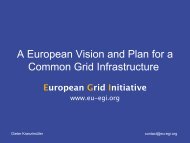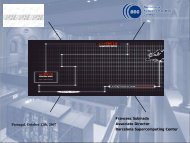e-Infrastructures Roadmap - Internet Society Nederland
e-Infrastructures Roadmap - Internet Society Nederland
e-Infrastructures Roadmap - Internet Society Nederland
- No tags were found...
You also want an ePaper? Increase the reach of your titles
YUMPU automatically turns print PDFs into web optimized ePapers that Google loves.
e-<strong>Infrastructures</strong> <strong>Roadmap</strong>Directions to: Making sense of sensorsVast amounts of data are being created all the time, through all kinds of sensors and sensor networksdistributed all over the world. These involve information from a broad spectrum of application areas,from environmental sensors such as seismic data, weather data, radioactivity, electromagnetic receptors,gravitational wave observatories, pollution measurements, temperature, ground water levels andfluvial data up to measurements of human and animal activities such as (air) traffic control, criticalinfrastructure status or RFID-tagging of animals. Signalling devices – such as satellites, radar equipment,radio beakons, large scale laser facilities and mobile telecom infrastructures – complement the systemas they can be used to actively manipulate events that need to be measured. The Galileo EuropeanSatellite navigation system that is about to be built can be used to map the virtual topology on to thereal world.Of course, many of these infrastructures are already hooked up to the research networks, but to beable to real-time interact with groups or unexpected combinations of them, to increase thecommunity that can use them in a sensible way and to be able to easily integrate them into newservices requires some degree of standardisation on the one one hand and technological enablers suchas grid middleware on the other. Measuring equipment is the equivalent of sensory input of ourcontinent and the data they produce together sets some boundary conditions on the kind of workscientist can deliver. The combination of real-time data combined with large-scale simulation renderedthrough the grid will enable scientists to better predict what is happening and help make betterpolicy decisions. Especially in emergency situations, such as a vast flooding of part of Europe or alarge-scale nuclear accident in the middle of the continent, this might save many lives. One might alsoneed resources that gather information about human activities on a macro scale, such as road usage,air traffic control data and sound pollution. That way, Europe will gain more insight into theoperational issues many of such infrastructures are facing.Since maintaining a full copy of every bit produced by every sensor is not scalable, it would log asensibly reduced amount of data to the European Grid Storage Facilities for long term preservation.The reflector mechanism could in time provide an ‘instant replay’ buffer of for instance 48 hours thatwould capture full volume data on all sources to be able to provide negative latency (so that whensome extraordinary event happens, one can copy the buffer and research the full data set instead of asubset).Next turn:Y Commission a reflector mechanism capable of becoming the secure and scalable front end forall European real-time data sources.Y Identify and approach top 100 sensor facilities valuable to the European Science Grid to beadded a.s.a.p.Y Create guidelines for conformance and provide a mechanism for all other sensors to be added attheir own initiative.Y Fund research in generic aggregation strategies for multiple real-time data streams and couplingwith model computations and historical data.End destinationY A rich ecosystem of grid-enabled devices available for distributed measuring of all relevantenvironmental parameters.Relevant policies, organisations, activities:Y ESA, LOFAR, ECMWF, ENBI, EMSC/IASPEI, GALILEO, and many others.Y DG Information <strong>Society</strong> and Media, DG JRC, DG Environment, DG Energy and Transport,DG Agriculture, FP7+, OECD, e-Content+ programme.Sensor data is also subject to the other needs of data with regards to storage, availability and/orcuration. Rather than having to redundantly create a buffering and redistribution infrastructure foreach of those continuous data outlets in order to facilitate their broad use, it would make muchsense to create a universal (distributed) facility that will take care of this. Such a facility would act asa fuse for their access – taking care of load balancing on the fly through the grid. Also, it can provide‘translations’ into a diversity of protocols. This would create a multi-tier infrastructure, whereprimary resources only need to take care of broadcasting the data once. This would enable mobilesensors to be deployed without delay when the need arises.42 43







